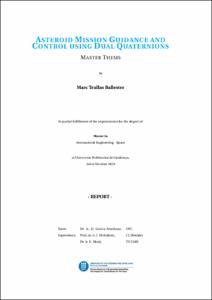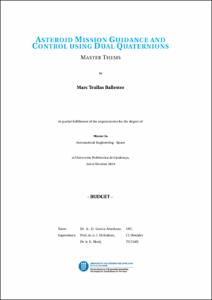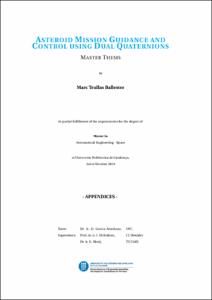Mostra el registre d'ítem simple
Study: Asteroid Mission Guidance and Control using Dual Quaternions
| dc.contributor | García-Almiñana, Daniel |
| dc.contributor | McMahon, J. |
| dc.contributor | Mooij, E. |
| dc.contributor.author | Trullàs Ballester, Marc |
| dc.contributor.other | Universitat Politècnica de Catalunya. Departament d'Enginyeria de Projectes i de la Construcció |
| dc.date.accessioned | 2020-02-04T17:24:21Z |
| dc.date.available | 2020-02-04T17:24:21Z |
| dc.date.issued | 2019-10-03 |
| dc.identifier.uri | http://hdl.handle.net/2117/176771 |
| dc.description.abstract | The investigation of small bodies in the Solar System such as asteroids and comets is of increasing interest to the space exploration community for scientific and security reasons. A key enabling technology is the availability to control position and attitude of spacecraft for asteroid close-proximity operations. Dynamics and control issues related to these operations have been investigated addressing the orbital and attitudemotion of the spacecraft with no coupling between them assumed. In reality however, the translational and rotational dynamics of spacecraft are generally coupled. It is therefore desirable to simultaneously take into account the full six degrees of freedom problem when developing pose (position and orientation) control laws for practical applications. One way of doing that is by expressing the state variables with dual quaternions, a mathematical formulation that naturally couples bothmotions in an efficient and compact way. The goal of this thesis is to determine what advantages and disadvantages can a six degrees of freedom controller based on dual quaternions bring over classicalmethods regarding asteroid close-proximity operations. To do so, a simulator was developed inMatlab R2016b with the two different representations: the dual quaternion one and the classical one using vectors for position, velocity and angular velocity, and quaternions for the attitude. Then, a controller was designed and optimized for each representation to follow a reference trajectory in three different scenarios, such as orbiting, hovering and landing on the asteroid Bennu. The dual quaternion representation has only two equations of motion instead of the four required for the classical one because of its compactness and natural way of coupling rotational and translational motions. However, results show that the dual quaternion controller takes 15% more computational time to achieve the same level of accuracy and energy consumption as the classical controller for the nominal scenarios. The reason for that is because the total number of operations involved in the integration of the equations of motions is higher. Moreover, a stability analysis was carried out and showed that controllers based on dual quaternions can handle much larger perturbations than the classical ones. Specifically, between 23 and 227 times larger perturbations depending on the scenario. Apart from that, results also proved that dual quaternion controllers can correct trajectory perturbations in a much faster and efficient way than the classical ones. Specifically, they have a settling time between 29% and 92% shorter, accumulate between 2.6 and 19 times less error and consume between 3.2 and 9.3 times less energy, depending on the scenario. |
| dc.language.iso | eng |
| dc.publisher | Universitat Politècnica de Catalunya |
| dc.subject | Àrees temàtiques de la UPC::Aeronàutica i espai |
| dc.subject.lcsh | Quaternions |
| dc.subject.lcsh | Asteroids--Exploration |
| dc.subject.lcsh | Space vehicles -- Control systems |
| dc.subject.other | Asteroids |
| dc.subject.other | Dual Quaternions |
| dc.subject.other | Control |
| dc.subject.other | Attitude |
| dc.subject.other | Pose |
| dc.subject.other | Quaternions |
| dc.subject.other | Landing |
| dc.subject.other | Hover |
| dc.subject.other | Orbit |
| dc.subject.other | Simulation |
| dc.title | Study: Asteroid Mission Guidance and Control using Dual Quaternions |
| dc.type | Master thesis |
| dc.subject.lemac | Quaternions |
| dc.subject.lemac | Asteroides -- Exploració |
| dc.subject.lemac | Vehicles espacials -- Sistemes de control |
| dc.identifier.slug | PRISMA-149658 |
| dc.rights.access | Open Access |
| dc.date.updated | 2019-10-14T09:14:02Z |
| dc.audience.educationlevel | Màster |
| dc.audience.mediator | Escola Superior d'Enginyeries Industrial, Aeroespacial i Audiovisual de Terrassa |
| dc.audience.degree | MÀSTER UNIVERSITARI EN ENGINYERIA AERONÀUTICA (Pla 2014) |
| dc.contributor.covenantee | Technische Universiteit Delft |




